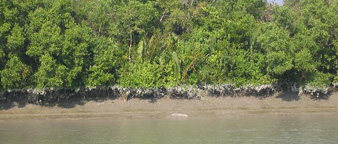|
|
| Sundarbans Forest |
Sundarbans, The largest single block of tidal halophytic mangrove forest in the world, located in the southern part of Bangladesh . It lies on the GANGES-BRAHMAPUTRA DELTA at the point where it merges with the BAY OF BENGAL . The forest is a showpiece of natural history with its array of trees and wildlife. It is also a centre of economic activities, such as extraction of timber, fishing and collection of honey. The forest consists of about 200 islands, separated by about 400 interconnected tidal rivers, creeks and canals. The Bangla words ban means forest, and the name Sundarban was coined from the forests of Sundari tree ie Sundari-ban.
The Sundarbans was originally measured (about 200 years ago) to be of about 16,700 sq km. Now it has dwindled to about 1/3 of the original size. Because of the partition of India , Bangladesh received 2/3 of the forest; the rest is on the Indian side. It is now estimated to be about 4,110 sq km, of which about 1,700 sq km is occupied by waterbodies.
The Sundarban was Reserved Forest in 1875. About 32,400 hectares of the Sundarban have been declared as three wildlife sanctuaries and came under the UNESCO World Heritage Site in 1999. |
 |
| |
|
Geology The tract of the Sundarbans is of recent origin, raised by the deposition of sediments formed due to soil erosion in the Himalayas . The process has been accelerated by tides from the sea face. The substratum consists mainly of Quaternary Era sediments, sand and silt mixed with marine salt deposits and clay.
Soil Soils of the Sundarbans mangrove forest differ from other inland soils in that they are subjected to the effects of salinity and waterlogging, which naturally affect the vegetation. In places soils are semi-solid and poorly consolidated. The pH ranges widely from 5.3 to 8.0.
Climate Since the forest is located on the south of the Tropic of Cancer and bounded by the northern limits of the Bay of Bengal , it is classified as tropical moist forest. The average annual maximum and minimum temperatures vary between 30 ° and 21 ° C. High temperatures occur from mid-March to mid-June and low in December and January. Annual rainfall in the Sundarbans is in the range of 1640-2000 mm, rainfall increases from west to the east. Most rainfall occurs during the monsoon from May to September.
Vegetation The vegetation is largely of mangrove type and encompasses a variety of plants including trees, shrubs, grasses, epiphytes and lianas. Being mostly evergreen, they possess more or less similar physiological and structural adaptations. Most trees have pneumatophores for aerial respiration. The prominent species is Sundari ( Heritiera fomes ) and Gewa ( Excoecaria agallocha ). Prain (1903) recorded 334 species under 245 genera. The typical mangrove species dominate the central part of the forest. There is a thick mat of the NIPA PLAM or Golpata by the side of almost all the canals.
Fauna The Sundarbans hosts a large variety of animals. It is the last stronghold of the Bengal Tiger ( Panthera tigris ). Within the forest habitats there are about 50 species of mammals, about 320 species of inland and migratory birds, about 50 species of reptiles, 8 species of amphibians and about 400 species of fish. Besides the spectacular Royal Bengal Tiger, the other notable mammalian fauna are Spotted deer, Barking deer, Rhesus macaque, Jungle cat, Leopard cat, the Indian porcupine, Otter and wild boar. Deer and wild boar constitute the main prey for the tiger. Some species including the Bengal tiger are endangered. The ecological diversity of the Sundarbans supports a large variety of birds. Over 50 species are known to be migratory and are mostly represented by the waterfowls. The egrets, storks, herons, bitterns sandpipers, curlew and numerous other waders are seen along the muddy banks. Of about 50 species of reptiles the largest member in the Sundarbans is the Estuarine crocodile, some of which may attain a length of about seven metres. Although once they were abundant in this mangrove habitat, their total number is now estimated to be around 250. Species of lizards, including the Monitor Lizards Varanus, turtles, and snakes are well-represented. Among the snakes, the King Cobra, Russell's Viper, Rock Python, Banded Krait and several species of sea snakes are notable.
|
|
| |
| |
|